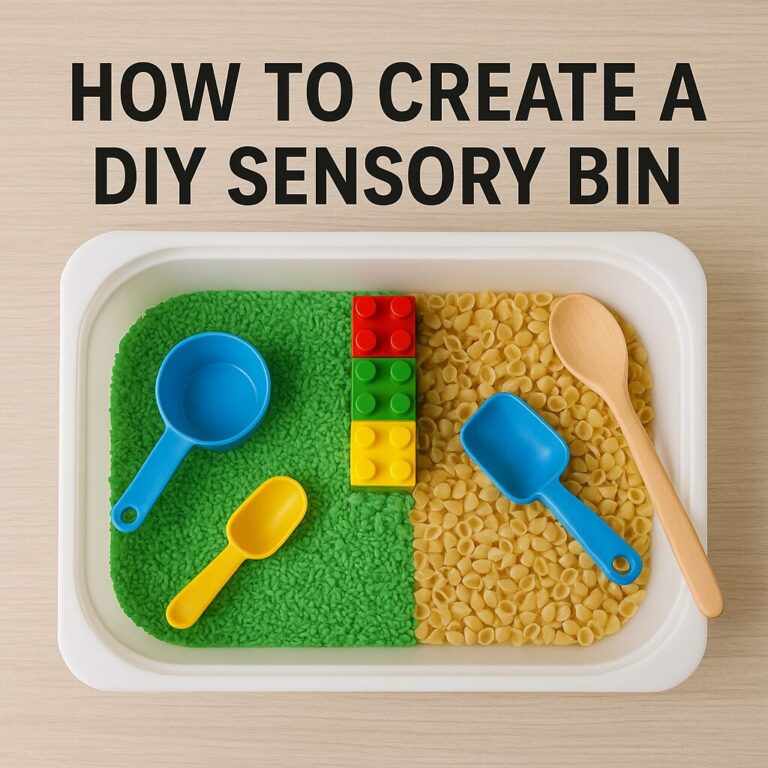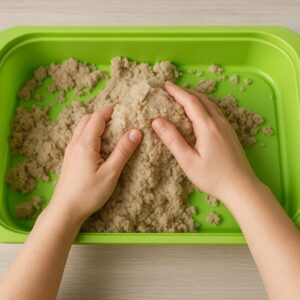Tactile play, calming routines, and creative exploration—all in one bin.
Sensory bins are one of the simplest and most effective ways to engage kids and adults alike in hands-on, calming play. Whether you’re supporting a sensory seeker, building fine motor skills, or just looking for a screen-free activity, a DIY sensory bin is affordable, customizable, and fun.
This guide walks you through how to build your own sensory bin at home with easy-to-find materials—plus 15+ filler ideas and tips for adapting to all ages.
🧠 What Is a Sensory Bin?
A sensory bin is a container filled with textured or themed materials that stimulate touch, sight, and sometimes sound or smell. Common elements include dry rice, water beads, or kinetic sand paired with scoopers, cups, or figurines.
These bins encourage:
- Tactile sensory input
- Calm, focused play
- Language development
- Creativity and pretend play
- Fine motor and coordination skills
🧰 What You Need to Get Started
Creating a sensory bin doesn’t require anything fancy. Here’s what you’ll need:
✔️ The Bin (Container)
Choose something shallow and wide:
- Clear plastic storage boxes with lids
- Under-bed containers (great for siblings or groups)
- Large baking trays or dollar-store tubs
🧩 Step-by-Step: Build Your DIY Sensory Bin
Step 1: Choose a Theme (Optional)
Themes help guide the contents and keep things exciting. Try:
- Ocean, farm, construction, fall leaves, outer space
- Alphabet, numbers, holidays, or emotions
Step 2: Pick a Base Filler
The base material makes up most of the bin. Choose by age and sensory preferences.
Popular fillers include:
- Dry Rice (dyed for color fun)
- Beans or Lentils
- Kinetic Sand
- Water Beads (for supervised play)
- Pom-Poms
- Shredded Paper
- Pasta (raw or cooked)
Step 3: Add Tools & Manipulatives
Use scoops, tongs, small toys, or cups for scooping, pouring, and imaginative play.
- Measuring spoons or cups
- Silicone cupcake molds
- Tweezers or tongs
- Plastic animals, letters, or action figures
Step 4: Supervise & Play
Lay down a towel or plastic sheet, and let the exploration begin! Model how to scoop, pour, sort, and talk about textures.
🏡 Easy Filler Ideas from Items You Already Have
| Material | Sensory Benefit | Notes |
|---|---|---|
| Dry Rice | Smooth, pouring | Color with food dye |
| Beans | Heavier, satisfying | Great for sorting |
| Water Beads | Cool, squishy, visual | Supervise closely |
| Kinetic Sand | Moldable, calming | Reusable and vacuum-safe |
| Shredded Paper | Crinkly, visual | Add essential oils if desired |
| Pom-Poms | Soft, colorful | Great for little hands |
| Pasta (dry) | Clinky & crunchy | Perfect for themed bins |
🌈 Favorite Pre-Made Sensory Bins (Amazon Picks)
🧠 Complete Sensory Bin Starter Kit
All-in-one set with rice, scoopers, cups, and a lidded box—ready to go for beginners or travel play.
🌊 Water Beads & Tools Kit
Includes pre-expanded beads, tongs, and animals for water-themed fun. Soothing and visually stimulating.
🚧 Construction Sensory Bin
Filled with rocks, toy trucks, and scoopers—perfect for a hands-on, themed dig site!
🧒 Adaptations by Age
| Age Group | Ideas & Tips |
|---|---|
| Toddlers | Supervise closely, use large pieces only |
| Preschool | Focus on sorting, pouring, color or shape games |
| School-Age | Add writing prompts, hidden letters/numbers |
| Teens & Adults | Use calming fillers like sand, beads, or herbs |
🛠 Sensory Bin Safety Tips
- Always supervise young children
- Avoid small pieces for kids under 3
- Keep water-based fillers in a sealed bin after use
- Clean and dry bins regularly to prevent mold or bacteria
🤔 FAQ: DIY Sensory Bins
How often should I rotate sensory bins?
Every 1–2 weeks keeps things fresh. You can rotate themes or just change the filler.
Can sensory bins be used in classrooms?
Yes! Use large bins for group activities or small trays for individuals.
What’s the best sensory bin for calming?
Water beads, kinetic sand, or soft pom-poms offer soothing textures.
🔗 Related Posts You’ll Love
- How to Use Sensory Sand Without the Mess
- Water Beads: Are They Safe and How to Use Them
- Top Sensory Toys for Tactile Seekers
As an Amazon Associate, SensoryGift.com earns from qualifying purchases. Thanks for supporting accessible sensory tools!



